- 1300 007 308
- info@ridapest.com.au
- Open 24 hours, 7 Days a week
A Comprehensive Guide to Australian Termites
Back to Blog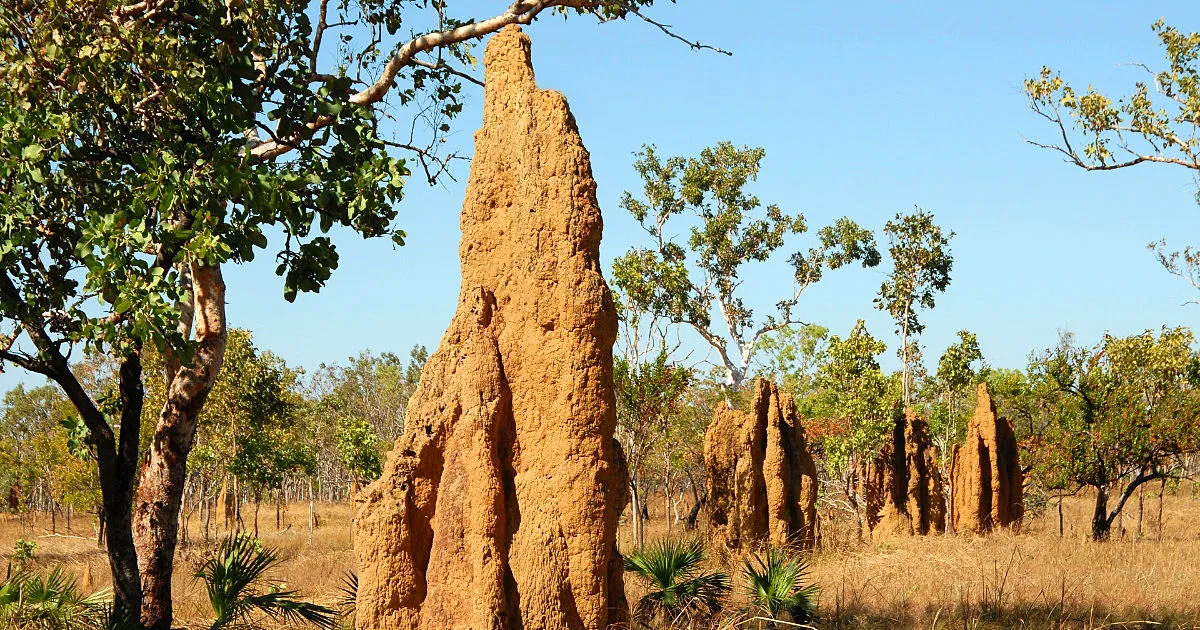
Table of Contents
Introduction to Australian Termites
Australian termites are fascinating insects that play a crucial role in the ecosystem.
They have been around for millions of years and have evolved to become one of the most successful groups of insects on Earth. For those living in Australia, termite infestations are a common problem due to the high number of termite species present in the country.
The Australian environment provides an ideal habitat for these pests, which can cause significant damage to homes and buildings if not addressed promptly. Australia is home to over 300 species of termites, making it one of the most termite-infested regions in the world. These termites are divided into three main categories based on their nesting habits: subterranean, drywood, and dampwood termites.
Subterranean termites build their nests underground while drywood termites create their colonies inside wood structures. Dampwood termites, on the other hand, prefer moist environments and can be found in decaying logs or damp areas within homes.
Some common Australian termite species include Mastotermes darwiniensis (giant northern termite), Cryptotermes brevis (West Indian drywood termite), Neotermes (ring-ant termite), Porotermes (dampwood termite), Heterotermes, Coptotermes, Schedorhinotermes, Microcerotermes and Amitetermes (compass termite). Each species has unique physical characteristics that enable quick identification.
While some may assume that only certain types of termites cause significant damage to structures like homes and buildings, any type can be problematic if left unaddressed.
Drywood termites are known culprits when it comes to causing long-lasting damage, as they can nest in wood structures for long periods. Subterranean termites, on the other hand, are known for causing significant damage to building foundations and other wooden structures.
Homeowners should never attempt to treat termite infestations themselves as it’s a job best left to professionals. Pest control companies have the tools and knowledge necessary to identify the extent of an infestation and determine the most effective course of action.
Common methods used include fumigation and baiting techniques. The treatment method used will depend on various factors such as the type of termite present, level of infestation, and location.
Fumigation is often effective in treating drywood termites while baiting techniques work well for subterranean termites. Homeowners should take preventative measures like regular inspections and keeping moisture levels low to reduce their risk of termite infestations.
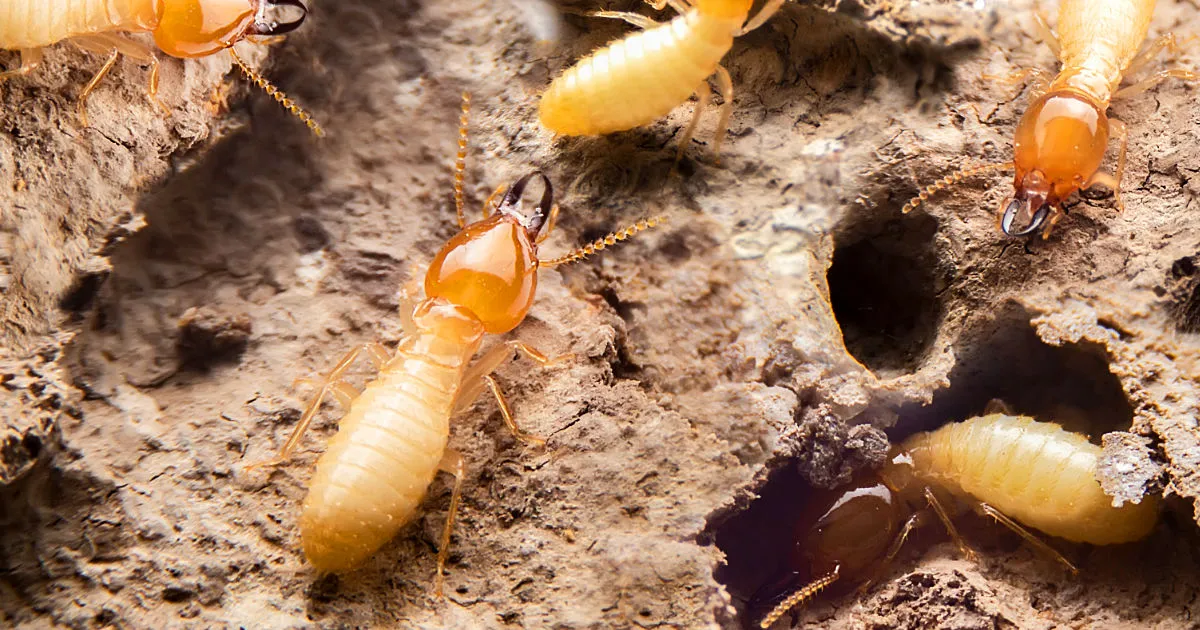
Understanding Termites: The Basics
Termites are a type of insect that belong to the order Isoptera. These insects are small and soft-bodied, and they are known for their ability to feed on wood and other cellulose-based materials. Termites have a unique social structure, with different members performing specific roles within the colony. The members of a termite colony include the queen, king, soldiers, workers, and alates (reproductive termites), all of which play vital roles in ensuring the survival of the colony.
Termites play an important role in the ecosystem by breaking down dead plant material such as trees and branches into organic matter that enriches soil nutrients necessary for plant growth. However as much as they are beneficial to nature they can also cause significant damage when they invade human structures such as homes by consuming wooden materials.
This is where Pest Control for Termites comes into play. It is important to identify different types of termites since some may require specific treatment techniques than others do.
A Termite Identification Guide can help distinguish between various species accurately by examining their physical characteristics such as coloration or head shape. Termites typically inhabit moist environments such as forests or wetlands but can also be found in dry areas.
Some species prefer to build their nests underground, while others construct their nests above ground. For example, Cryptotermes brevis is a drywood termite that mainly infects wooden structures in Australia and can cause considerable damage if left unchecked.
Overall, understanding termites’ basics is essential in preventing and dealing with potential termite damage.
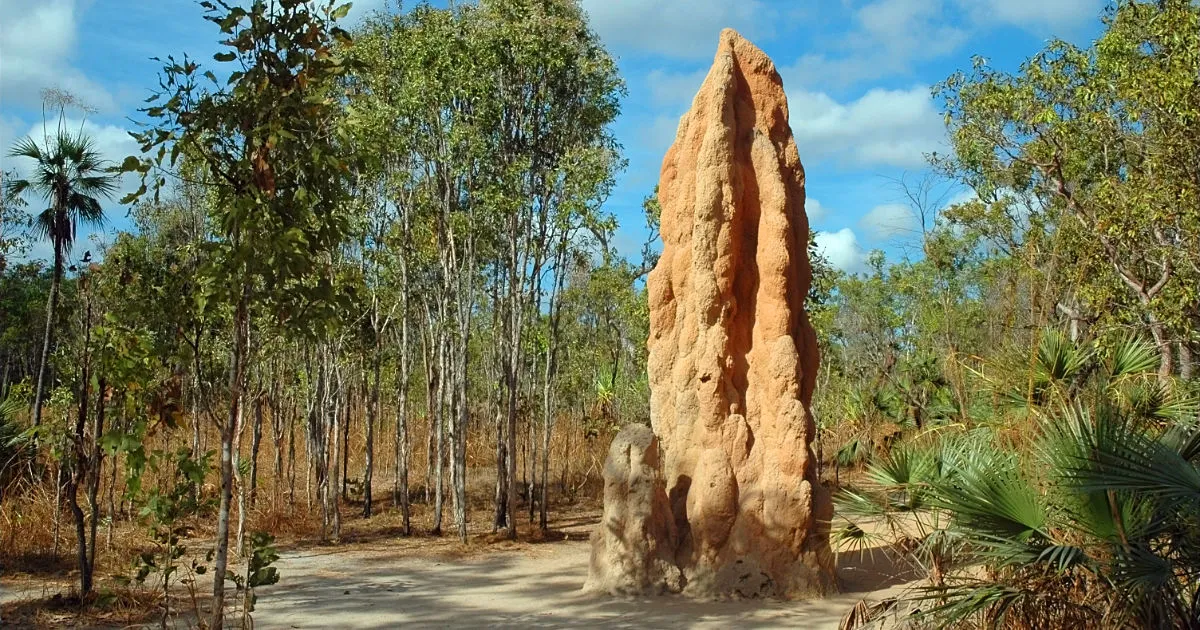
Mastotermes darwiniensis (giant northern termite)
Mastotermes darwiniensis, commonly known as the giant northern termite, is one of the most aggressive and destructive termite species in Australia. It is found primarily in the Northern Territory, but also in parts of Western Australia and Queensland. This species has the largest soldiers and workers of any known termite species, with workers reaching up to 15mm in length.
The giant northern termite is a dampwood termite that typically feeds on moist wood. Unlike other Australian termite types that build mounds, this species constructs its nests underground and can attack buildings and structures through timber that is in direct contact with the soil.
Mastotermes darwiniensis has been named as one of the most destructive pests in Australia because of its ability to cause extensive damage to homes and other wooden structures. They have been observed causing significant structural damage within weeks or months of an infestation.
This means homeowners need to be vigilant when it comes to protecting their property against this pest by conducting regular inspections for signs of termites. Identifying Mastotermes darwiniensis can be difficult because they are similar in appearance to other Australian termite species such as Coptotermes or Schedorhinotermes, which makes it essential to consult a Termite Identification Guide to determine which type of termite you are dealing with.
| Feature | Description |
| Size | Workers are about 10-12 mm long, soldiers are about 15-17 mm long, and alates are about 35-50 mm long with a 50-70 mm wingspan. |
| Color | Workers are light brown to dark brown, soldiers are reddish brown, and alates are light brown with dark brown markings. |
| Head | The head of the worker is rounded, with a short snout. The head of the soldier is large and rectangular, with a powerful mandible. The head of the alate is long and slender, with large compound eyes. |
| Antennae | The antennae of the worker are 12-14 segments long, the antennae of the soldier are 16-18 segments long, and the antennae of the alate are 18-20 segments long. |
| Wings | The wings of the alate are long and slender, with a clear membrane. |
| Habitat | Mastotermes darwiniensis is found in northern Australia, in areas with a warm climate. They build their nests in soil, and can travel long distances to find food. |
| Diet | Mastotermes darwiniensis is a herbivore, and feeds on wood, plant material, and other organic matter. |
| Pest status | Mastotermes darwiniensis is a major pest of timber and other organic materials. They can cause significant damage to homes, businesses, and other structures. |
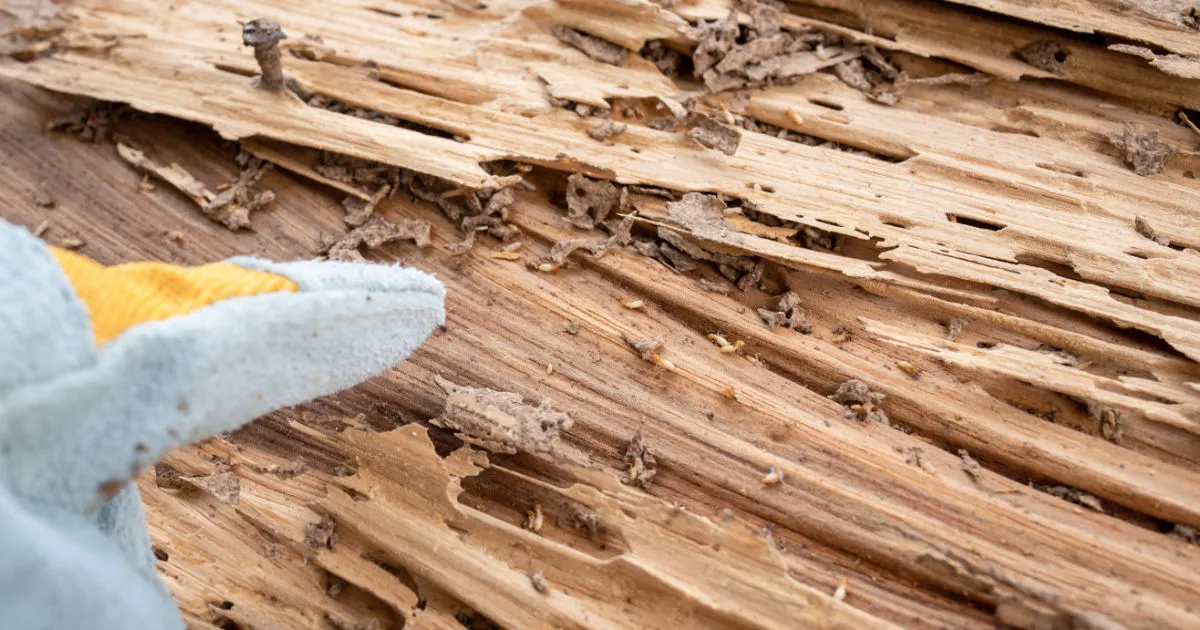
Cryptotermes brevis (West Indian drywood termite)
Cryptotermes brevis, also known as the West Indian drywood termite, is a species of termite that has become an invasive pest in many parts of the world. It’s one of the more common termites found in coastal areas of Australia, and these pests often infest dry wood in homes and other structures. Unlike other Australian termite types, Cryptotermes brevis doesn’t require contact with soil to survive. Instead, the termites build their colonies inside wooden structures or furniture. Because Cryptotermes brevis termites don’t need soil to survive, they can be difficult to detect and treat. These pests are capable of causing significant damage to wooden structures if left unchecked over time. Infestations can lead to weakened structural integrity and costly repairs for homeowners.
Cryptotermes brevis termites are often confused with other species such as Coptotermes or Heterotermes due to their similar appearance. However, there are distinct differences in behaviour and biology that make it important for homeowners to properly identify the specific type of termite present in their home before attempting any kind of treatment.
Treatment options for drywood termites like Cryptotermes brevis typically involve localised treatments using specialised insecticide sprays or fumigation techniques. In addition, preventative measures such as sealing cracks and crevices where termites might enter a structure can help reduce the risk of future infestations.
Overall, understanding the different termite species in Australia is an essential component of effective pest control for termites. By learning more about species like Cryptotermes brevis and taking steps to prevent infestations from occurring, homeowners can protect their properties from costly damage caused by these destructive pests.
| Feature | Description |
| Size | Workers are about 2-3 mm long, soldiers are about 4-5 mm long, and alates are about 6-8 mm long with a 10-12 mm wingspan. |
| Color | Workers are light brown to dark brown, soldiers are reddish brown, and alates are light brown with dark brown markings. |
| Head | The head of the worker is rounded, with a short snout. The head of the soldier is large and rectangular, with a powerful mandible. The head of the alate is long and slender, with large compound eyes. |
| Antennae | The antennae of the worker are 10-12 segments long, the antennae of the soldier are 14-16 segments long, and the antennae of the alate are 16-18 segments long. |
| Wings | The wings of the alate are long and slender, with a clear membrane. |
| Habitat | Cryptotermes brevis is found in all states of Australia, except Tasmania. They build their nests in dry wood, and can travel long distances to find food. |
| Diet | Cryptotermes brevis is a herbivore, and feeds on wood, plant material, and other organic matter. |
| Pest status | Cryptotermes brevis is a major pest of timber and other organic materials. They can cause significant damage to homes, businesses, and other structures. |
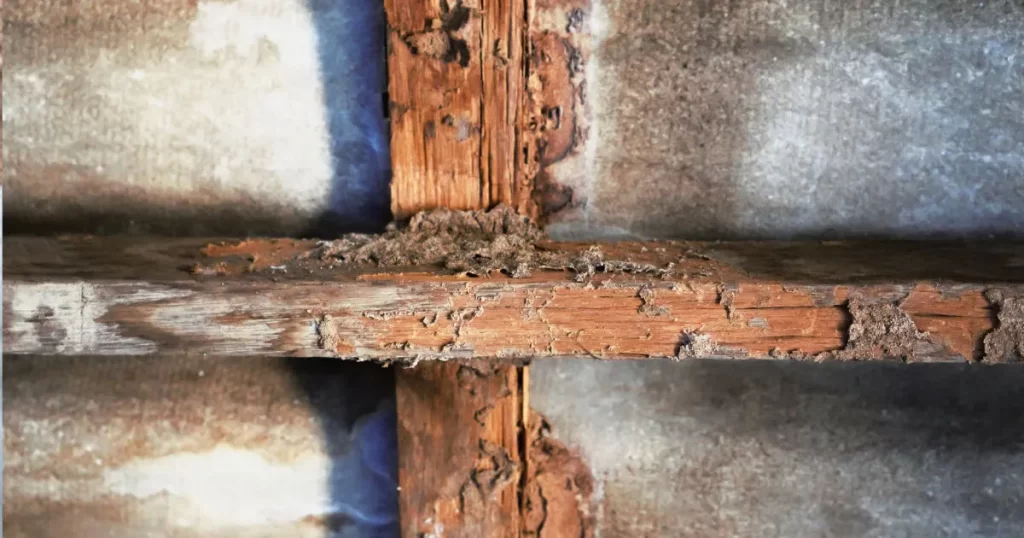
Neotermes (ring-ant termite)
Neotermes is a genus of termites that belongs to the family Kalotermitidae. The termite species within this genus primarily infest wood and can cause significant damage to wooden structures. They are commonly referred to as “ring-ant termites” due to their distinctive habit of building mud tubes and tunnels in the shape of rings around wooden objects.
Compared to other Australian Termite Types, Neotermes are relatively small in size, measuring around 4-6mm long. They are also pale in colour, with a yellowish-brown or light brown body.
These termites are most commonly found in coastal areas of Australia, particularly in the northern parts of Western Australia and Queensland. Despite their small size, Neotermes can cause considerable Termite Damage if left untreated.
They feed on both hardwood and softwood timber and can quickly weaken the structural integrity of a building if they infest it.
Like other termite species found across Australia such as Heterotermes or Coptotermes, Neotermes can be controlled through effective Pest Control. Regular inspections by licensed pest control professionals can help detect any signs of termite activity early on making it easier to eradicate them. Apart from common Australian termite species like Mastotermes darwiniensis (giant northern termite) and Cryptotermes brevis (West Indian drywood termite), Neotermes is one of the many types that homeowners should keep an eye out for when it comes to preventing Termite Damage.
| Feature | Description |
| Size | Workers are about 3-4 mm long, soldiers are about 5-6 mm long, and alates are about 7-9 mm long with a 12-14 mm wingspan. |
| Color | Workers are light brown to dark brown, soldiers are reddish brown, and alates are light brown with dark brown markings. |
| Head | The head of the worker is rounded, with a short snout. The head of the soldier is large and rectangular, with a powerful mandible. The head of the alate is long and slender, with large compound eyes. |
| Antennae | The antennae of the worker are 12-14 segments long, the antennae of the soldier are 16-18 segments long, and the antennae of the alate are 18-20 segments long. |
| Wings | The wings of the alate are long and slender, with a clear membrane. |
| Habitat | Neotermes is found in coastal Australia, in areas with a warm climate. They build their nests in trees and other woody plants. |
| Diet | Neotermes is a herbivore, and feeds on wood, plant material, and other organic matter. |
| Pest status | Neotermes is a minor pest of timber and other organic materials. They can cause damage to trees and other woody plants, but they are not a major threat to homes and businesses. |
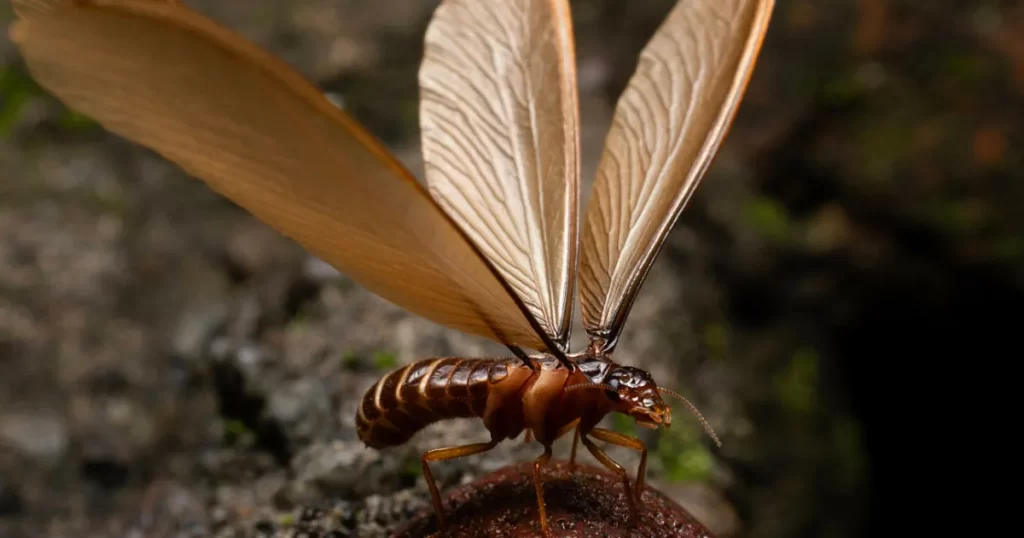
Porotermes (dampwood termite)
The Porotermes, commonly known as dampwood termites, are a type of Australian termite that reside in damp or moist timber. Unlike the West Indian drywood termite or Microcerotermes species, they do not require contact with soil for survival and can live solely on wood.
As their name suggests, these termites thrive in areas where there is high moisture content such as basements, bathrooms or kitchens. Porotermes create large galleries that are often visible on the surface of wood. They usually infest dead trees or fallen branches and are not commonly found in man-made structures. However, if a building has moisture problems such as plumbing leaks or faulty gutters and downpipes, these termites can enter through cracks and crevices. If left untreated, Porotermes can cause significant damage to wooden structures and furniture. Their presence is indicated by piles of faecal pellets near infested areas.
Termite treatment options for Porotermes include liquid chemical barriers around the perimeter of the structure, bait stations strategically placed around the property as well as wood preservative treatments for affected timber. While not as common of a problem compared to other Australian termite types like Mastotermes darwiniensis or Coptotermes species which cause more widespread damage to homes and buildings; homeowners should still be aware of dampwood termites like Porotermes that can cause significant damage if left unchecked especially if you have any moisture issues within your home.
| Feature | Description |
| Size | Workers are about 1-2 mm long, soldiers are about 3-4 mm long, and alates are about 5-7 mm long with a 10-12 mm wingspan. |
| Color | Workers are light brown to dark brown, soldiers are reddish brown, and alates are light brown with dark brown markings. |
| Head | The head of the worker is rounded, with a short snout. The head of the soldier is large and rectangular, with a powerful mandible. The head of the alate is long and slender, with large compound eyes. |
| Antennae | The antennae of the worker are 10-12 segments long, the antennae of the soldier are 14-16 segments long, and the antennae of the alate are 16-18 segments long. |
| Wings | The wings of the alate are long and slender, with a clear membrane. |
| Habitat | Porotermes is found in all states of Australia, except Tasmania. They build their nests in damp or moist wood, such as under floorboards, in the roof space, or in soil. |
| Diet | Porotermes is a herbivore, and feeds on wood, plant material, and other organic matter. |
| Pest status | Porotermes is a minor pest of timber and other organic materials. They can cause damage to wood in buildings, but they are not a major threat to homes and businesses. |
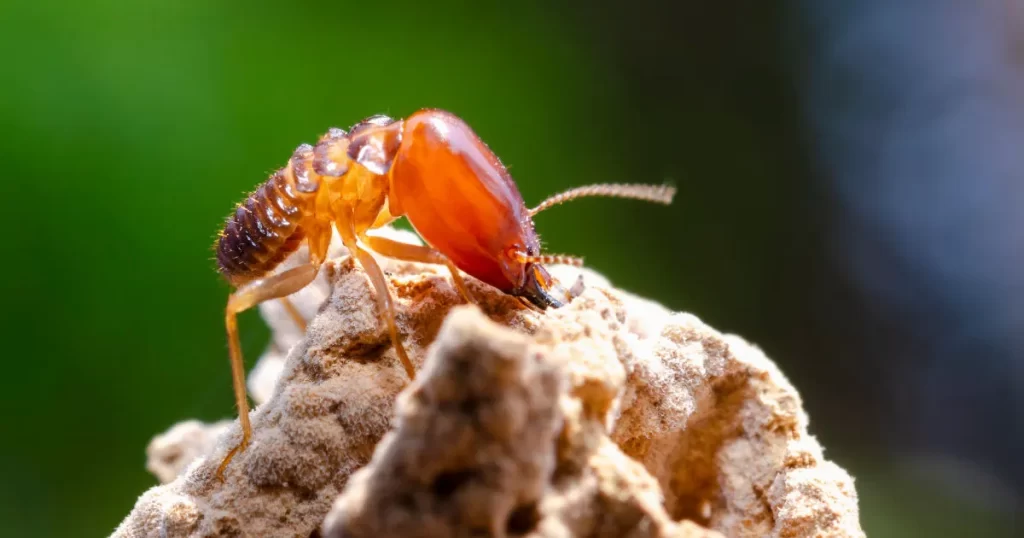
Heterotermes
is a genus of termites that are found in Australia and some parts of Asia. They are known to be highly destructive and are considered pests in many areas.
The members of this genus have a distinct head shape, which is narrower than the rest of their body. Unlike other termites that live in colonies, Heterotermes termites usually live alone or in small groups.They feed on cellulose-based materials such as wood, paper, and cardboard, which makes them a threat to homes and other structures made from wood.
The damage caused by Heterotermes termites can be severe and can lead to costly repairs if not addressed in time.
These termites also have straight antennae that are about the same length as their bodies. If you suspect an infestation of Heterotermes termites, it’s best to call a pest control expert who can provide effective termite treatment solutions.
Preventive measures such as regular inspections for signs of termite damage or presence can help detect any infestations before they become too serious. Additionally, it’s crucial to ensure that wooden structures are treated with insecticides or termite-resistant coatings during construction or renovation projects.
While Heterotermes termites may not be as well-known as some of the other Australian Termite Types such as Mastotermes darwiniensis (giant northern termite) or Amitetermes (compass termite), they pose just as much of a threat to wooden structures due to their feeding habits and destructive nature. It’s essential to take proactive steps towards preventing infestations by implementing preventive measures like regular inspections and ensuring proper treatment during construction or renovation projects.
| Feature | Description |
| Size | Workers are about 2-3 mm long, soldiers are about 4-5 mm long, and alates are about 6-8 mm long with a 10-12 mm wingspan. |
| Color | Workers are light brown to dark brown, soldiers are reddish brown, and alates are light brown with dark brown markings. |
| Head | The head of the worker is rounded, with a short snout. The head of the soldier is large and rectangular, with a powerful mandible. The head of the alate is long and slender, with large compound eyes. |
| Antennae | The antennae of the worker are 10-12 segments long, the antennae of the soldier are 14-16 segments long, and the antennae of the alate are 16-18 segments long. |
| Wings | The wings of the alate are long and slender, with a clear membrane. |
| Habitat | Heterotermes is found in all states of Australia, except Tasmania. They build their nests in soil, and can travel long distances to find food. |
| Diet | Heterotermes is a herbivore, and feeds on wood, plant material, and other organic matter. |
| Pest status | Heterotermes is a major pest of timber and other organic materials. They can cause significant damage to homes, businesses, and other structures. |
Coptotermes
is a genus of subterranean termites that belong to the family Rhinotermitidae. They are considered one of the most destructive termite species in Australia, and are responsible for causing significant damage to homes and other buildings. is commonly known as the “termite king” due to its large size, with some colonies containing up to 2 million individuals.
One of the most striking features of Coptotermes is their ability to cause extensive damage within a short period of time. They feed on wood and other cellulose-based materials, meaning they can quickly destroy wooden structures and furniture.
Their destructive tendencies make them one of the most feared termite species in Australia.
They are often found in areas where there is a lot of moisture, such as around leaky pipes or damp basements. They can also be found in trees and other wooden structures outside of homes and buildings. Infestations can be difficult to detect, as they tend to remain hidden within walls or other concealed areas until significant damage has already been done.
Fortunately, there are several ways to prevent and treat Coptotermes infestations. Regular inspections by a professional pest control company can help identify signs of termite activity before serious damage occurs.
Treatment options include chemical barriers around homes or buildings, baiting systems that target entire colonies, and fumigation for severe infestations.
| Feature | Description |
| Size | Workers are about 2-3 mm long, soldiers are about 4-5 mm long, and alates are about 6-8 mm long with a 10-12 mm wingspan. |
| Color | Workers are light brown to dark brown, soldiers are reddish brown, and alates are light brown with dark brown markings. |
| Head | The head of the worker is rounded, with a short snout. The head of the soldier is large and rectangular, with a powerful mandible. The head of the alate is long and slender, with large compound eyes. |
| Antennae | The antennae of the worker are 10-12 segments long, the antennae of the soldier are 14-16 segments long, and the antennae of the alate are 16-18 segments long. |
| Wings | The wings of the alate are long and slender, with a clear membrane. |
| Habitat | Coptotermes is found in all states of Australia, except Tasmania. They build their nests in soil, and can travel long distances to find food. |
| Diet | Coptotermes is a herbivore, and feeds on wood, plant material, and other organic matter. |
| Pest status | Coptotermes is a major pest of timber and other organic materials. They can cause significant damage to homes, businesses, and other structures. |
Nasutitermes
is a genus of termites that is common in Australia. This termite species in Australia is known for its unique head that has a long, pointed snout or nasus.
The nasus is used by these termites to spray chemicals as a form of defence against predators and to communicate with other members of the colony. There are several types of Nasutitermes found in Australia, including Nasutitermes exitiosus (Destructive Nasute Termite), Nasutitermes fumigatus (Gumtree Termite), and Nasutitermes walkeri (Walker’s Termite).
These Australian termite types are most commonly found in the eastern regions of the country and can cause significant damage to timber structures. The destructive nature of Nasutitermes makes them one of the most important termite species in Australia from an economic perspective.
The damage caused by these termites can be extensive and costly to repair.
Like other termite species, treatment for Nasutitermes infestations requires specialised knowledge and strategies tailored to the specific type of termite and severity of infestation.
Effective treatment options include physical barriers, baiting systems, chemical treatments, or a combination thereof. While not as well-known as some other Australian termite types such as Mastotermes darwiniensis or Cryptotermes brevis, Nasutitermes is an important genus within the context of comprehensive guide to Australian termites research.
| Feature | Description |
| Size | Workers are about 2-3 mm long, soldiers are about 4-5 mm long, and alates are about 6-8 mm long with a 10-12 mm wingspan. |
| Color | Workers are light brown to dark brown, soldiers are reddish brown, and alates are light brown with dark brown markings. |
| Head | The head of the worker is rounded, with a short snout. The head of the soldier has a long, pointed snout that can squirt a sticky substance to defend the colony. The head of the alate is long and slender, with large compound eyes. |
| Antennae | The antennae of the worker are 10-12 segments long, the antennae of the soldier are 14-16 segments long, and the antennae of the alate are 16-18 segments long. |
| Wings | The wings of the alate are long and slender, with a clear membrane. |
| Habitat | Nasutitermes is found in all states of Australia, except Tasmania. They build their nests in soil, and can travel long distances to find food. |
| Diet | Nasutitermes is a herbivore, and feeds on wood, plant material, and other organic matter. |
| Pest status | Nasutitermes is a major pest of timber and other organic materials. They can cause significant damage to homes, businesses, and other structures. |
Conclusion
Are Australian termites causing havoc in your home? Don’t worry, Ridapest Termite & Pest Control in Cairns, QLD, has got you covered! We specialise in tackling Australian termite infestations, providing comprehensive services to safeguard your property. With our expert team and advanced methods, we’ll effectively eliminate termites and protect your home from further damage. Don’t let these destructive pests compromise your peace of mind. Schedule a professional termite inspection in Cairns today by visiting our termite inspection page and take the first step towards a termite-free environment. Trust Ridapest for reliable and effective termite control in Cairns, QLD.
Discover More Cairns Pest Insights:
- 🐜 Unravel the world of Australian Ants! From tiny trailblazers to diligent workers, learn how to manage these clever critters in your Cairns surroundings.
- 🦗 Ready to tackle the creepy crawlies? Dive into the realm of Australian Cockroaches and gain the upper hand against these persistent pests. Cairns cockroach control made simple!
Frequently Asked Questions
What are Australian termites?
Australian termites are insects belonging to the order Isoptera and are known for their ability to feed on wood and other cellulose-based materials. They have a unique social structure and inhabit moist environments such as forests or wetlands.
How many types of termites are there in Australia?
There are over 300 species of termites in Australia, classified into three main categories based on their nesting habits: subterranean, drywood, and dampwood termites.
What are some common Australian termite species?
Some common Australian termite species include Mastotermes darwiniensis (giant northern termite), Cryptotermes brevis (West Indian drywood termite), Neotermes (ring-ant termite), Porotermes (dampwood termite), Heterotermes, Coptotermes, Schedorhinotermes, Microcerotermes and Amitetermes (compass termite).
Can homeowners treat termite infestations themselves?
Homeowners should never attempt to treat termite infestations themselves as it’s a job best left to professionals. Pest control companies have the tools and knowledge necessary to identify the extent of an infestation and determine the most effective course of action.
What are some preventative measures to reduce the risk of termite infestations?
Homeowners should take preventative measures like regular inspections and keeping moisture levels low to reduce their risk of termite infestations. Sealing cracks and crevices where termites might enter a structure can also help reduce the risk of future infestations.
What should homeowners do if signs of termite activity are detected?
Homeowners should contact licensed pest control professionals if signs of termite activity are detected. This can help detect any signs of termite activity early on, making it easier to eradicate them and prevent further damage to their property.
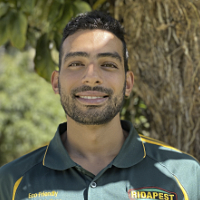
Or Mathias
Passionate owner of Ridapest Termite & Pest Control in Cairns, Australia, leveraging over five years of industry experience to provide pet and family-friendly pest control solutions. Known for his dedication to customer satisfaction and environmental safety, Or has grown Ridapest into a leading service, setting new standards in pest control while keeping homes and businesses safe.
